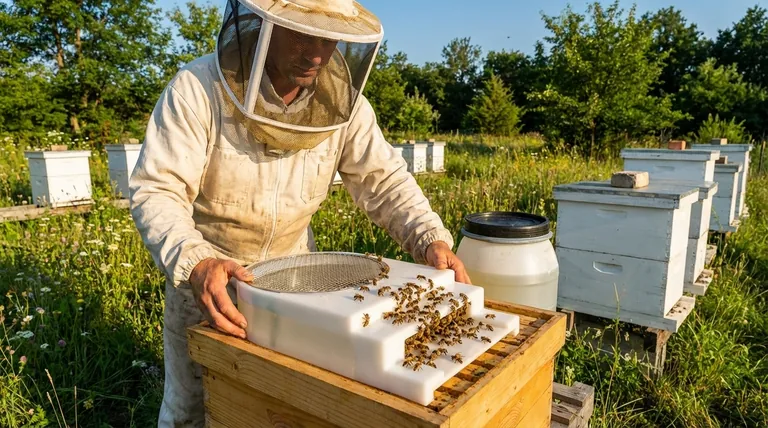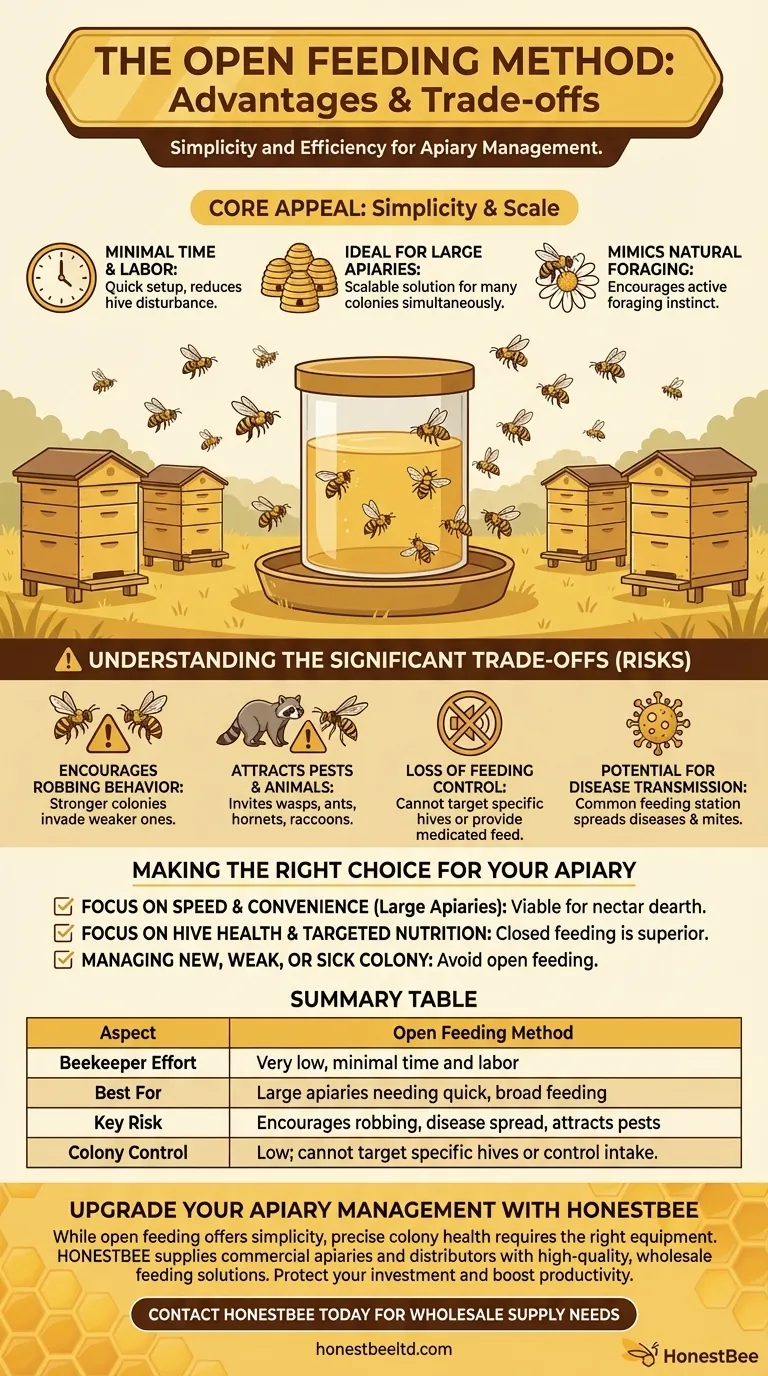At its core, the open feeding method for honeybees is prized for its simplicity and efficiency. It is a fast, low-effort technique where a beekeeper provides a sugar solution in a central, open location for multiple colonies to access. This approach requires minimal equipment and time, making it an attractive option for managing large apiaries or for beekeepers seeking a low-maintenance solution.
The primary advantage of open feeding is its unparalleled convenience for the beekeeper. However, this convenience comes at the significant cost of losing control over which colonies get fed and exposing your bees to increased risks.

The Core Appeal: Simplicity and Scale
The decision to use open feeding often comes down to saving time and labor, especially when managing numerous hives. It removes the need to interact with each colony individually.
Minimal Time and Labor
Open feeding is the quickest way to provide food. The beekeeper simply prepares the sugar syrup and places it in a feeder some distance away from the hives.
There is no need to open individual hives, which reduces disturbance to the colonies and physical work for the beekeeper.
Ideal for Large Apiaries
For operations with dozens or hundreds of hives, feeding each one individually is a monumental task.
Open feeding allows a single food source to serve the entire apiary simultaneously, making it a scalable solution for large-scale supplemental feeding.
Mimics Natural Foraging
This method encourages bees to fly out and forage for the food source, which is similar to how they would collect nectar from a large flower bloom.
It keeps the foraging instinct active, though directed at an artificial source.
Understanding the Significant Trade-offs
While easy for the beekeeper, open feeding introduces several serious risks to the health and stability of the colonies. This lack of control is the method's fundamental weakness.
Encourages Robbing Behavior
When a strong colony discovers a rich food source, it may trace it back to weaker nearby hives, leading to "robbing."
Robbing is when bees from a stronger hive invade a weaker one to steal its honey stores, often resulting in the death of the weaker colony's queen and its eventual collapse.
Attracts Pests and Other Animals
An open food source is an invitation to more than just your bees. Wasps, ants, hornets, and even larger animals like raccoons may be attracted to the feeder.
This not only depletes the food intended for your bees but can also create a dangerous environment around the apiary.
Loss of Feeding Control
With open feeding, you cannot control how much food each colony takes. Stronger, more dominant colonies will gather the most food, while weaker hives that may need it most get outcompeted.
You also lose the ability to provide medicated feed or specific nutritional supplements to a single colony in need, as the food is shared by all.
Potential for Disease Transmission
A common feeding station where bees from many different colonies congregate can become a vector for transmitting diseases and mites, like Varroa, throughout the entire apiary.
Making the Right Choice for Your Apiary
Choosing a feeding method requires weighing the need for convenience against the goal of precise colony management and health.
- If your primary focus is speed and convenience for a large, healthy apiary: Open feeding can be a viable way to provide supplemental food during a nectar dearth.
- If your primary focus is hive health and targeted nutrition: The closed feeding method is vastly superior, as it ensures food goes only to the intended colony and prevents robbing.
- If you are managing a new, weak, or sick colony: You should avoid open feeding entirely, as these hives are the most vulnerable to being robbed and outcompeted.
Ultimately, understanding the risks is key to deciding if the efficiency of open feeding is worth the loss of control for your specific goals.
Summary Table:
| Aspect | Open Feeding Method |
|---|---|
| Beekeeper Effort | Very low; minimal time and labor |
| Best For | Large apiaries needing quick, broad feeding |
| Key Risk | Encourages robbing, disease spread, and attracts pests |
| Colony Control | Low; cannot target specific hives or control intake |
Upgrade Your Apiary Management with HONESTBEE
While open feeding offers simplicity, precise colony health management requires the right equipment. HONESTBEE supplies commercial apiaries and beekeeping equipment distributors with high-quality, wholesale-focused feeding solutions and supplies. From individual hive feeders to large-scale systems, we provide the tools you need to feed efficiently while minimizing risks.
Let us help you protect your investment and boost your operation's health and productivity.
Contact HONESTBEE today to discuss your wholesale supply needs!
Visual Guide

Related Products
- Classic Boardman Entrance Bee Feeder Hive Front Feeding Solution
- Boardman Entrance Bee Feeder Durable Galvanized Steel and Wood Construction for Beekeeping
- HONESTBEE Professional Hive Top Bee Feeder Feeding Solution
- HONESTBEE Entrance Bee Feeder Professional Hive Nutrition Solution for Beekeeping
- HONESTBEE Round Hive Top Bee Feeder for Syrup
People Also Ask
- How is the mesh ladder and barrier installed in the feeder box? A Step-by-Step Guide to Prevent Bee Drowning
- Should bees be fed after installing a nucleus hive? Ensure Your New Colony Thrives
- What is the best feeder for bees? Choose the Right Feeder for Your Hive's Success
- What are the different types of honey bee feeders? Choose the Right Feeder for Your Hive
- What types of bee feeders are available for beginners? Start with the Simple Entrance Feeder



















